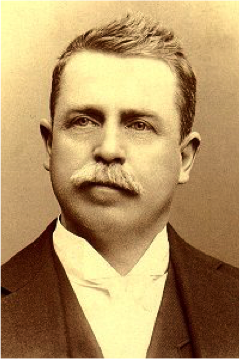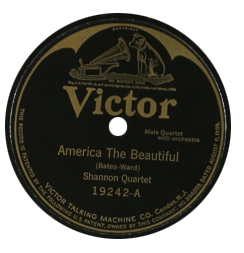Newark Birthplace of “America the Beautiful”
Samuel Augustus Ward and “Materna”
The 2016 celebration of Newark’s 350th anniversary is a fitting time to tell the story of the birthplace of one of the most beloved of American patriotic songs, “America the Beautiful.”
Grace Church in Newark, whose elegant edifice has occupied the intersection of Broad and Walnut Streets since 1848, has been influential in many ways, notes James Hopkins, organist and music director. One of two national historic landmarks in the city, Grace was founded in 1837 as the second parish of the Episcopal Church organized in the City of Newark. It has played an important role in Newark and the Episcopal Church over the years.

Music has always been prominent at Grace Church. In one of the earliest references to its musical tradition, an 1854 letter to the editor praised the boy choir’s “accuracy of time and tune.”
“However, the most famous contribution Grace Church has made to the world of music has little to do with the organ or children’s choirs,” Hopkins says. “It is in the form of a patriotic song.”
The 19th century Grace Church organist Samuel Augustus Ward gained wide renown for his composition of the hymn tune “Materna,” but in the 20th century, after its pairing with Katherine Lee Bates’ famous poem, “America the Beautiful,” it evolved into an informal national anthem.
“Materna” was written by Ward in 1882, and first published in 1906 by the Knickerbocker Press. The tune was initially set to the text, “O Mother dear, Jerusalem.” “Materna” was used frequently at Grace Church, at first in manuscript form, and later appeared in the church’s hymnal.
Seven years after Ward’s death, a perfect marriage was made of Ward’s tune with the words of Bates’ poem. Ward, born in 1847, was a native son of Newark and served as organist and choirmaster at Grace Church from 1880 until his death in 1903. He was known particularly for his ability to engage a choir and for his spontaneous organ improvisations. He was largely self-taught in music, and according to Edward Batailles’ Grace Church in Newark: the First Hundred Years, his only formal training was in harmony with Professor Algar.
The Episcopal Church adopted Ward’s “Materna” with its original text in The New Hymnal (1916) and The Hymnal (1940), and with “America the Beautiful” in The Hymnal (1982.) The original text was written in the 16th century by an author known only by the initials F.B.P.
"America the Beautiful”
Katherine Lee Bates, 1882
O beautiful for spacious skies,
for amber waves of grain,
For purple mountain majesties
Above the fruited plain!
America! America! God shed His grace on thee,
And crown thy good with brotherhood
From sea to shining sea!
O beautiful for pilgrim feet
Whose stern impassioned stress
A thoroughfare for freedom beat
Across the wilderness.
America! America!
God mend thine ev'ry flaw,
Confirm thy soul in self-control,
Thy liberty in law.
O beautiful for glorious tale
Of liberating strife,
When valiantly for man's avail
Men lavish precious life.
America! America!
May God thy gold refine
Till all success be nobleness,
And ev'ry gain divine.
O beautiful for patriot dream
That sees beyond the years
Thine alabaster cities gleam
Undimmed by human tears.
America! America!
God shed His grace on thee,
And crown thy good with brotherhood
From sea to shining sea.

“O mother dear, Jerusalem
O mother dear, Jerusalem, When shall I come to thee? When shall my sorrows have an end?
Thy joys when shall I see?
O happy harbor of the saints, O sweet and
pleasant soil! In thee no sorrow may be found,
No grief, no care, no toil.
No murky cloud o’ershadows thee, No mist nor
darksome night; There ev’ry soul shines as the
sun, For God himself gives light.
There lust and lucre cannot dwell; There envy
bears no sway; There is no hunger, heat, nor
cold, But pleasure ev’ry way.
Thy gardens and thy gallant walks Continually
are green; There grow such sweet and pleasant
flowers As nowhere else are seen.
Quite through the streets with silver sound The
flood of life doth flow, Upon whose banks on
every side The wood of life doth grow.
There trees for evermore bear fruit, And
evermore do spring; There evermore the angels
be, And evermore do sing.
Jerusalem, Jerusalem, God grant that I may see
Thine endless joy, and of the same Partaker ever be!
O mother dear, Jerusalem, When shall I come to thee? When shall my sorrows have an end? Thy joys when shall I see? The text as found in The Hymnal (1940) begins:
Of course, Ward’s “Materna” is now used almost exclusively with the better-known patriotic verse by Wellesley College English Professor Katherine Bates.

She is reported to have been inspired to write the poem in 1890, after her visit to the summit of Pike’s Peak in Colorado.
Every child in the U.S. learns the first verse of Bates’ poem:
O beautiful for spacious skies,
For amber waves of grain,
For purple mountain majesties
Above the fruited plain!
America! America!
God shed His grace on thee,
And crown thy good with brotherhood
From sea to shining sea!

In 1970, almost 90 years after Ward composed this now immortal tune, he was inducted into the Songwriter’s Hall of Fame. How pleased he would be today to hear all the many sung and recorded versions of this classic, by choirs and singers nationwide, from Grace Church in Newark to Ray Charles and Willie Nelson, Renee Fleming, and Newark’s own Sarah Vaughan and Whitney Houston. For many Americans, “America the Beautiful” is even more beloved than our national anthem, “The Star Spangled Banner.”
Renee Fleming sings “America the Beautiful” at Harvard University
Native Newarker Sarah Vaughan sings “America the Beautiful” at the U.S. bicentennial celebration in 1976.
About Grace Church
Grace was founded in 1837 and worships in an 1848 church designed by Richard Upjohn, one of the most celebrated architects of the Gothic Revival. Upjohn’s other buildings include the 1846 Trinity Wall Street Church in New York City. At the consecration of the building in 1848, the parish was noted as the “standard bearer of Anglican Catholicism in northern New Jersey” according to the then Bishop Doane of New Jersey.
Located in Newark’s downtown near City Hall and the Federal courts, Grace Church was assigned to the National Register of Historic Places in 1992. Its rich history of fine liturgy and music is well known. The church’s first prominent organist was Samuel Augustus Ward, composer of the melody Materna in 1882, adapted later for the patriotic song America the Beautiful.
The church's musical tradition was maintained and carried forward with distinction by James McGregor, director of the music emeritus, during his nearly 50-year tenure, and Joseph Arndt, from 2008-2015. James Hopkins was appointed director of music in 2015.
For more information about music at Grace Church please CLICK HERE.
Helen Paxton AHP Associates
Media contact: James Hopkins (Grace Church)







